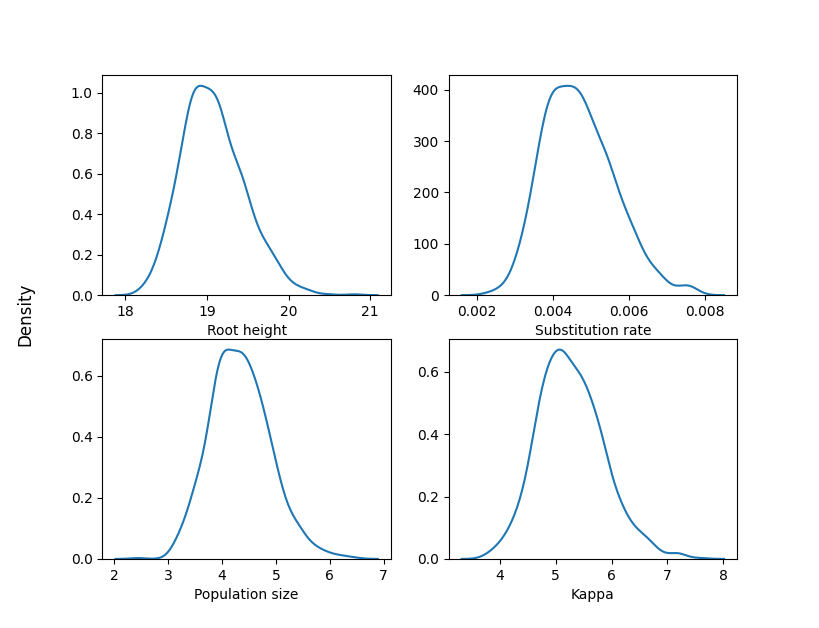Quick start#
torchtree requires a JSON file containing models and algorithms. A configuration file can be generated using torchtree-cli, a command line-based tool. This two-step process allows the user to adjust values in the configuration file, such as hyperparameters.
torchtree-cli implements several subcommands, each corresponding to a different type of inference algorithm.
A list of available subcommands can be obtained by running torchtree-cli --help.
The following subcommands are available:
advi: Automatic differentiation variational inference
hmc: Hamiltonian Monte Carlo
map: Maximum a posteriori
mcmc: Markov chain Monte Carlo
Each subcommand/algorithm requires a different set of arguments which can be obtained by running torchtree-cli <subcommand> --help.
torchtree-cli requires an alignment file in FASTA format and a tree file in either Newick or NEXUS format. While torchtree uses the DendroPy library to parse and manipulate phylogenetic trees, it is recommended to use a Newick file due to the numerous variations of the NEXUS format.
Let’s explore a few examples of how to use these programs using an influenza A virus dataset containing 69 DNA sequences. The alignment and tree files are located in the data directory of the torchtree repository.
1 - Generating a configuration file#
Unrooted tree with GTR+W4 model#
We are going to generate a JSON file containing an unrooted tree model with a GTR substitution model. Rate heterogeneity across sites is modelled using a discretized Weibull distribution with 4 rates categories. This is similar to the more commonly used discretized Gamma distribution site model but the Weibull distribution has the advantage to be easily differentiable.
torchtree-cli advi -i fluA.fa -t fluA.tree -m GTR -C 4 > fluA-advi-unrooted.json
By default, the priors are:
Exponential prior on the branch lengths with a mean of 0.1.
Flat Dirichlet priors on the rate biases and equilibrium state frequencies of the GTR model.
Exponential prior on the shape parameter of the Weibull distribution with a mean of 0.5.
Time tree with strict clock and constant coalescent model#
The following command generates a JSON file containing a time tree model with a strict molecular clock and a constant coalescent prior. There is no rate heterogeneity across sites and the substitution model is the Hasegawa-Kishino-Yano model (HKY).
torchtree-cli advi -i fluA.fa -t fluA.tree -m HKY --clock strict --coalescent constant > fluA-advi-rooted.json
By default, the remaining priors are:
Proper CTMC reference prior for the substitution rate parameter.
The prior density of the population size parameter \(\theta\) of the constant coalescent model is \(1/\theta\).
Flat Dirichlet prior on the equilibrium state frequencies of the HKY model.
Lognormal prior on the kappa parameter (ratio of transition and transversion rates) of the HKY model with location 1.0 and scale 1.25.
Inferring the model parameters using HMC can be done by replacing the advi subcommand with hmc in the previous command:
torchtree-cli hmc -i fluA.fa -t fluA.tree -m HKY --clock strict --coalescent constant --stem fluA-hmc-rooted > fluA-hmc-rooted.json
2 - Running torchtree#
Once we are happy with the configuration file and adjusted the prior distributions, we can run the inference algorithm using the following command:
torchtree fluA-advi-rooted.json
torchtree will generate sample.csv and sample.trees files containing parameter and tree samples drawn from the variational distribution.
The sample.csv is compatible with Tracer and the trees in sample.trees can be summarized with treeannotator from the BEAST package.
Plotting the results#
Here are the kernel density estimates of the posterior distributions for some parameters:
import matplotlib.pyplot as plt
import pandas as pd
import seaborn as sns
df = pd.read_csv("samples.csv", sep="\t")
df.rename(
columns={
"tree.root_height": "Root height",
"branchmodel.rate": "Substitution rate",
"coalescent.theta": "Population size",
"substmodel.kappa": "Kappa",
},
inplace=True,
)
fig, axes = plt.subplots(2, 2)
fig.supylabel("Density")
columns = ["Root height", "Substitution rate", "Population size", "Kappa"]
for ax, col in zip(axes.flat, columns):
sns.kdeplot(data=df, x=col, ax=ax)
ax.set(ylabel=None)
plt.show()
